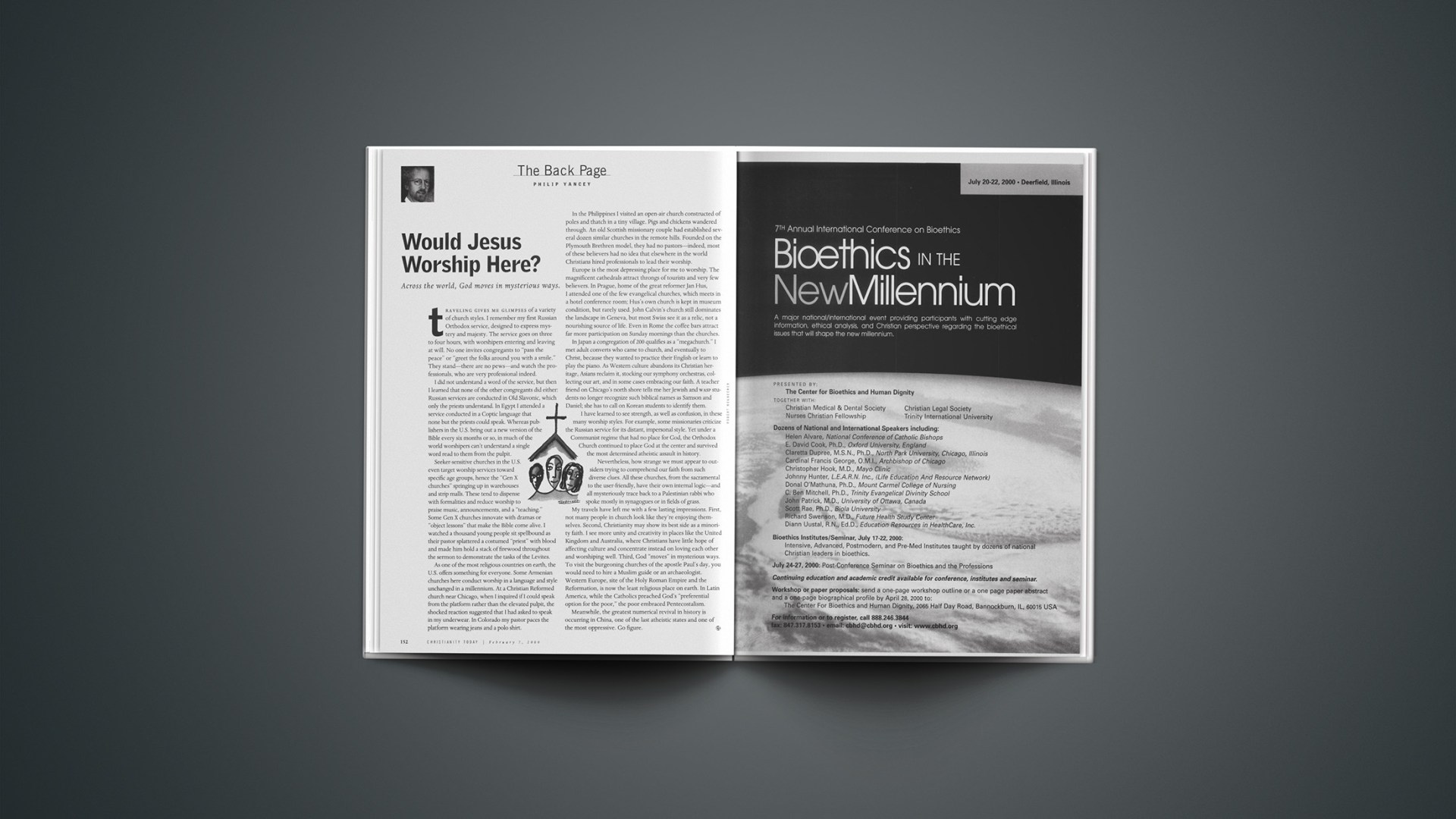Traveling gives me glimpses of a variety of church styles. I remember my first Russian Orthodox service, designed to express mystery and majesty. The service goes on three to four hours, with worshipers entering and leaving at will. No one invites congregants to “pass the peace” or “greet the folks around you with a smile.” They stand—there are no pews—and watch the professionals, who are very professional indeed.I did not understand a word of the service, but then I learned that none of the other congregants did either: Russian services are conducted in Old Slavonic, which only the priests understand. In Egypt I attended a service conducted in a Coptic language that none but the priests could speak. Whereas publishers in the U.S. bring out a new version of the Bible every six months or so, in much of the world worshipers can’t understand a single word read to them from the pulpit. Seeker-sensitive churches in the U.S. even target worship services toward specific age groups, hence the “Gen X churches” springing up in warehouses and strip malls. These tend to dispense with formalities and reduce worship to praise music, announcements, and a “teaching.” Some Gen X churches innovate with dramas or “object lessons” that make the Bible come alive. I watched a thousand young people sit spellbound as their pastor splattered a costumed “priest” with blood and made him hold a stack of firewood throughout the sermon to demonstrate the tasks of the Levites. As one of the most religious countries on earth, the U.S. offers something for everyone. Some Armenian churches here conduct worship in a language and style unchanged in a millennium. At a Christian Reformed church near Chicago, when I inquired if I could speak from the platform rather than the elevated pulpit, the shocked reaction suggested that I had asked to speak in my underwear. In Colorado my pastor paces the platform wearing jeans and a polo shirt.In the Philippines I visited an open-air church constructed of poles and thatch in a tiny village. Pigs and chickens wandered through. An old Scottish missionary couple had established several dozen similar churches in the remote hills. Founded on the Plymouth Brethren model, they had no pastors—indeed, most of these believers had no idea that elsewhere in the world Christians hired professionals to lead their worship.Europe is the most depressing place for me to worship. The magnificent cathedrals attract throngs of tourists and very few believers. In Prague, home of the great reformer Jan Hus, I attended one of the few evangelical churches, which meets in a hotel conference room; Hus’s own church is kept in museum condition, but rarely used. John Calvin’s church still dominates the landscape in Geneva, but most Swiss see it as a relic, not a nourishing source of life. Even in Rome the coffee bars attract far more participation on Sunday mornings than the churches. In Japan a congregation of 200 qualifies as a “megachurch.” I met adult converts who came to church, and eventually to Christ, because they wanted to practice their English or learn to play the piano. As Western culture abandons its Christian heritage, Asians reclaim it, stocking our symphony orchestras, collecting our art, and in some cases embracing our faith. A teacher friend on Chicago’s north shore tells me her Jewish and WASP students no longer recognize such biblical names as Samson and Daniel; she has to call on Korean students to identify them. I have learned to see strength, as well as confusion, in these many worship styles. For example, some missionaries criticize the Russian service for its distant, impersonal style. Yet under a Communist regime that had no place for God, the Orthodox Church continued to place God at the center and survived the most determined atheistic assault in history. Nevertheless, how strange we must appear to outsiders trying to comprehend our faith from such diverse clues. All these churches, from the sacramental to the user-friendly, have their own internal logic—and all mysteriously trace back to a Palestinian rabbi who spoke mostly in synagogues or in fields of grass. My travels have left me with a few lasting impressions. First, not many people in church look like they’re enjoying themselves. Second, Christianity may show its best side as a minority faith. I see more unity and creativity in places like the United Kingdom and Australia, where Christians have little hope of affecting culture and concentrate instead on loving each other and worshiping well. Third, God “moves” in mysterious ways. To visit the burgeoning churches of the apostle Paul’s day, you would need to hire a Muslim guide or an archaeologist. Western Europe, site of the Holy Roman Empire and the Reformation, is now the least religious place on earth. In Latin America, while the Catholics preached God’s “preferential option for the poor,” the poor embraced Pentecostalism. Meanwhile, the greatest numerical revival in history is occurring in China, one of the last atheistic states and one of the most oppressive. Go figure.
Related Elsewhere
Earlier Philip Yancey columns:Doctor’s Orders (Dec. 2, 1999)Getting to Know Me (Oct. 25, 1999)The Encyclopedia of Theological Ignorance (Sept. 6, 1999)Writing the Trinity (July 12, 1999)Can Good Come Out of This Evil? (June 14, 1999)The Last Deist (Apr. 5, 1999)Why I Can Feel Your Pain (Feb. 8, 1999)What The Prince of Egypt Won’t Tell You (Dec. 7, 1998)What’s a Heaven For? (Oct. 26, 1998)The Fox and the Writer (Sept. 7, 1998)Fear and Faith in the Middle East (July 13, 1998)And the Word Was … Debatable (May 18, 1998)A Cure for Spiritual Deafness (Apr. 6, 1998)Jesus’ Unanswered Prayers (Feb. 9, 1998)More Philip Yancey archives
Copyright © 2000 Christianity Today. Click for reprint information.










